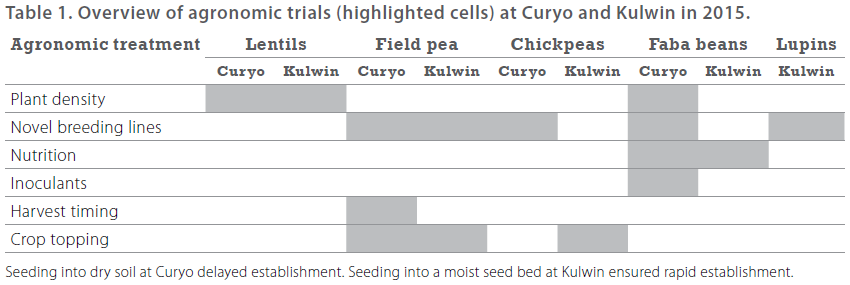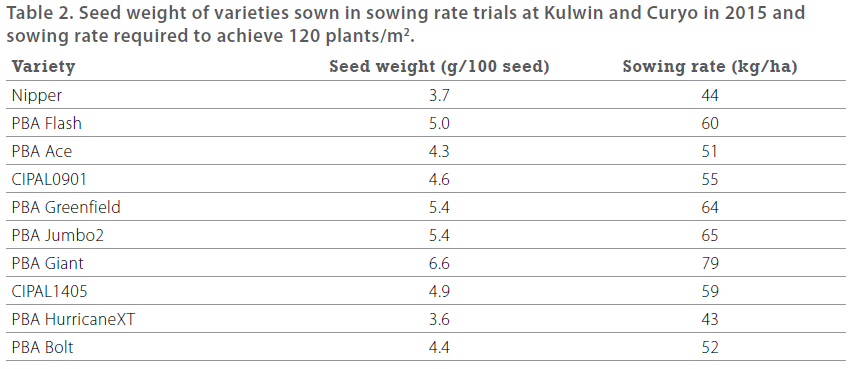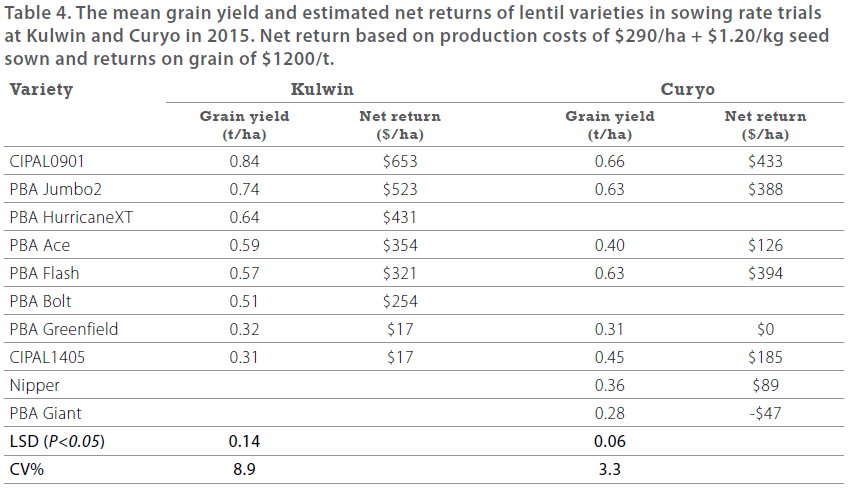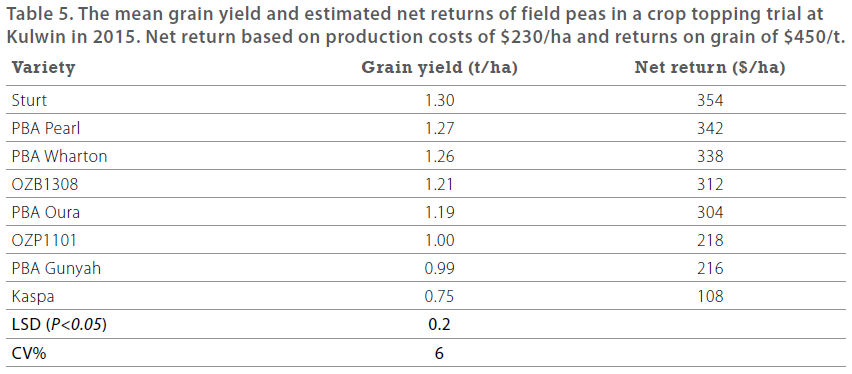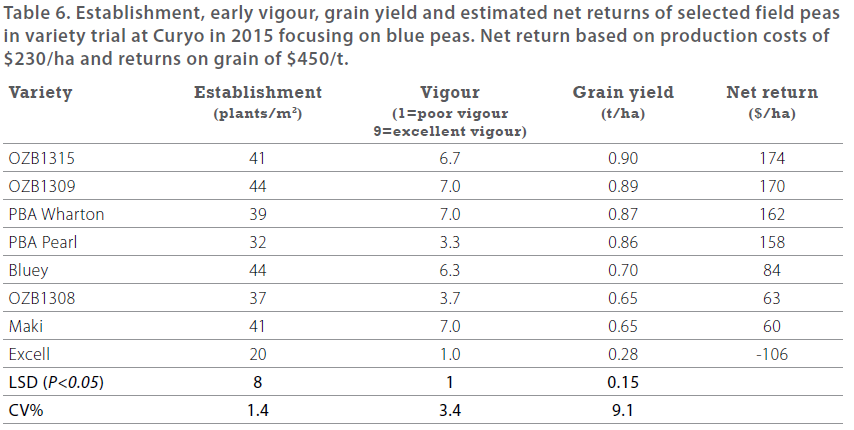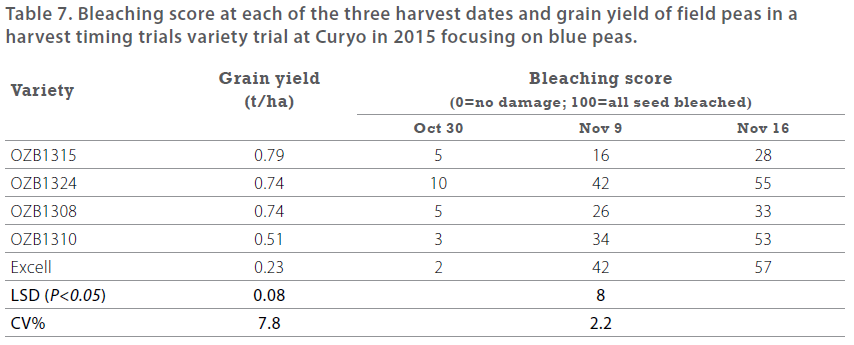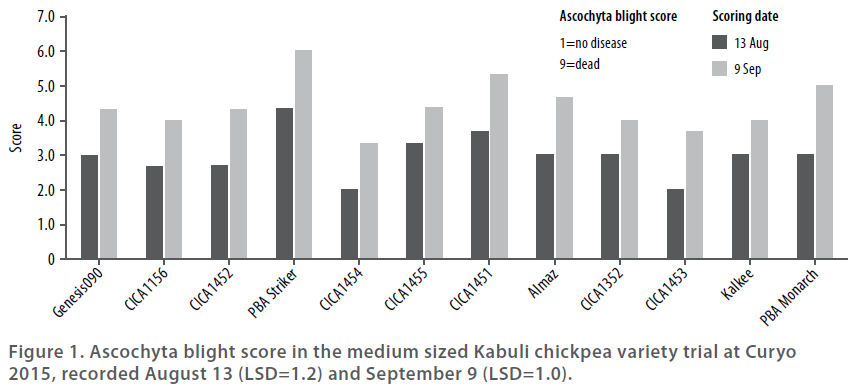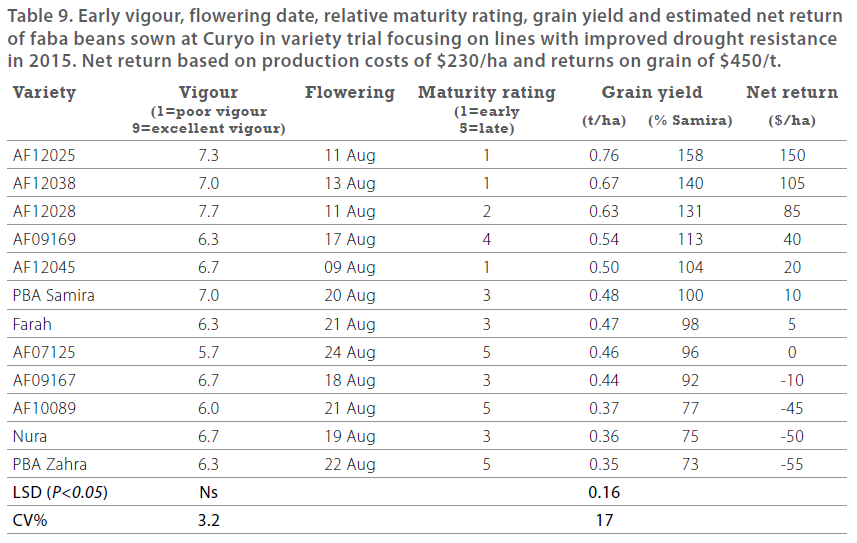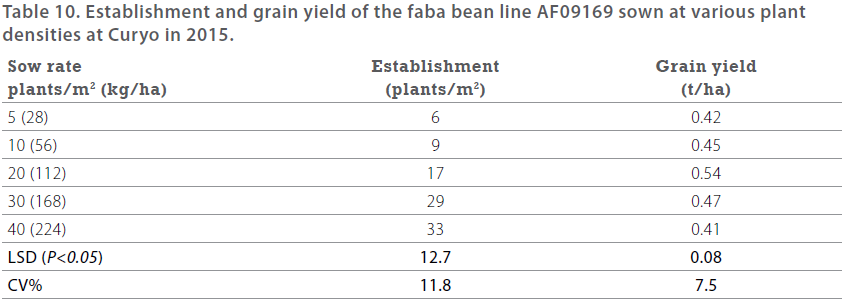The Southern Pulse Agronomy program conducts a wide range of agronomic and variety pulse trials across all rainfall zones of south-eastern Australia. Its primary aim is to improve yield and yield stability, ultimately leading to increased profitability and adoption of new varieties by growers. In this report, key results from selected trials conducted in the southern (Curyo) and central (Kulwin) Mallee 2015 are highlighted.
LENTILS
Recently a range of higher yielding lentil varieties were released, with improvements in a range of agronomic traits including biomass development, canopy structure, disease resistance, herbicide tolerance, maturity and pod retention. In addition, growers are sowing crops earlier to maximise yield potential and reduce risks of heat and terminal drought stress, particularly in the Mallee. Research in 2015 focused on identifying potential advantages of lower seeding rates for these new varieties, without incurring yield penalties.
FIELD PEAS
Peas, similar to all pulses, can be a key component in the effective weed management strategies used in modern farming systems. They are particularly useful for controlling grasses as most varieties allow crop-topping prior to harvest. Recently in the breeding program, several higher yielding blue pea lines were developed as potential replacements for Excell. Research in 2015 investigated the impacts of crop-topping and delayed harvesting on the yield and quality of peas, particularly in blue peas, which can be susceptible to bleaching.
CHICKPEAS
Trials in the last few years have demonstrated the profitability of slightly larger sized Kabuli chickpeas, such as PBA Monarch in the southern Mallee. Trials in 2015 continued to assess the performance of a number of new breeding lines in drier environments.
FABA BEANS
In the breeding program, several lines with significant improvements in yield in dry areas have been identified. Improved moisture conservation techniques mean that, beans may be considered within the farming system, particularly as they are one of the best nitrogen fixing pulses. In 2015, a number of new breeding lines were tested with varied nutritional and inoculation treatments to maximise yields.
LUPINS
In 2015, the agronomy program worked with the breeding program to identify novel new germplasm specifically suitable for south eastern Australia. At the central Mallee site a range of breeding lines were assessed to identify those more suitable for the modern farming systems used in these regions.
The Southern Pulse Agronomy program is funded by GRDC (DAV00113), AgVic (DEDJTR), SARDI and NSWDPI. It undertakes a range of agronomic trials to ensure that the benefits of new pulse varieties are maximised and delivered to growers. Further details relating to trial methodology and other measurements recorded will be available in a detailed report early in 2016.
TAKE HOME MESSAGES
- Most pulses were profitable at Mallee trial sites in 2015, especially lentils.
- When choosing new varieties or changing agronomic treatments it is important to look at
long-term information rather than individual seasons. Varieties like PBA Jumbo2 lentils and
PBA Pearl and PBA Wharton field peas performed well indicating yield stability. - Seeding rate of lentils in the Mallee could be lowered from 120 to 80 plants/m2, particularly
with new disease resistant varieties sown early. - A new isolate of ascochyta blight was discovered at Curyo which has virulence on previously
resistant chickpea varieties.
AIM
To improve yield and yield stability of pulse crops, ultimately leading to increased profitability and adoption of new varieties by growers.
TRIAL DETAILS
RESULTS AND INTERPRETATION
LENTILS
Estimated sowing rates targeting 120 plant/m2 varied from 43kg/ha for PBA HurricaneXT to 79kg/ha for the larger seeded green lentil PBA Giant (Table 2).
At both trial sites there was no interaction between seeding rate and variety. However, the average yield of varieties varied significantly at both sites. There were significant differences in seeding rates at Curyo, but not Kulwin (Table 3).
Yields were generally higher at Kulwin than Curyo, due to the Kulwin site receiving more rainfall in April (37.9mm v. 20.8mm) and the resultant early establishment.
CIPAL0901 had the highest yields at both trial sites in 2015 (0.84t/ha at Kulwin and 0.66t/ha at Curyo). CIPAL0901 is an early maturing line (significantly earlier than all other varieties in the trial) that always performs well in extremely dry/short seasons like 2015, but long-term yields are more than 10 per cent lower than newer varieties such as PBA Jumbo2 and PBA Bolt. In addition, its disease resistance characteristics have not attained the desired level. It is unlikely to ever be released as a commercial variety.
PBA Jumbo2 was the highest yielding commercial variety in 2015, with yields not significantly different from CIPAL0901. This indicates the continuing yield stability of PBA Jumbo2. It has also performed extremely well in better seasons and is currently the highest yielding variety across south eastern Australia in the long term. In addition, it has good resistance to ascochyta blight and botrytis grey mould, lowering risks of disease when early sown.
Due to the dry season, varieties were unable to produce full canopies as would be expected in a year with average rainfall (Curyo – 249.7mm GSR, Kulwin – 211.9mm GSR). As a result, it was anticipated that there would be no significant interaction between varieties and seeding rates. However, at Curyo there was a significant response to plant density across all varieties, meaning that they all showed a similar trend (Table 3). All sowing rates produced similar yields, except at 40 plants/m2, where it was significantly lower.
Due to historically high grain prices, a lentil crop producing 0.3t/ha in 2015 could ‘break even’ or be profitable, depending on input costs. At Kulwin all varieties were profitable, and at Curyo only PBA Giant made a loss. Lentils were the most profitable crop at both trial sites, producing up to $653/ha at Kulwin and $433/ha at Curyo (Table 4).
FIELD PEAS
The trial at Kulwin was not affected by the crop topping treatment because of the extremely dry season and hot days in October. Similar to the lentils, sites were harvested earlier than has been observed previously.
Grain yields of peas ranged from 0.75t/ha for Kaspa to 1.30t/ha for Sturt (Table 5). Similar to long term results, PBA Pearl and PBA Wharton were two of the highest yielding varieties in the trial.
It was expected that Sturt would perform well, as it has consistently in dry seasons. Yields from the new blue pea line OZB1308 were not significantly different from the highest yielding varieties, indicating potential for blue types in dry areas.
Field peas were profitable at Kulwin in 2015, with return up to $350/ha.
At Curyo both trials were affected by P-Pickle T toxicity, which is a variety-specific phytotoxic response to the application of the seed dressing. This seed dressing was applied to all seed sown in the research program. The trial clearly demonstrated a range of responses to the application of P-pickle T, which in affected varieties reduced establishment and early vigour (Table 6). The old blue pea variety Excell was severely affected by this toxicity, which significantly reduced establishment and vigour. PBA Pearl and OZB1308 were moderately affected, while all other varieties showed no significant effects.
Grain yields of field peas were generally less at Curyo than Kulwin, but were still at profitable levels, ranging from 0.90t/ha for a new blue pea line, OZB1315 to 0.28t/ha for Excell. PBA Wharton and PBA Pearl performed similar to the highest yielding lines, even though PBA Pearl was significantly affected by the P-Pickle-T toxicity.
Another trial investigated the effects of delayed harvest resulting in significant bleaching (Table 7). Varieties showed significantly different bleaching responses to the harvest timings, not for grain yield. The lines OZB1315 and OZB1308 appeared to have better resistance to bleaching than Excell and other lines in the trial (Table 7).
CHICKPEAS
At Curyo, despite the relatively dry season, in early August a significant outbreak of ascochyta blight was observed in the trial (Figure 1). Symptom assessment indicated that this isolate of ascochyta was different from those observed previously in Victorian trials, having virulence on resistant lines such as Genesis090 and PBA Slasher.
From the results in this trial, there appears to be some differences in resistance to this isolate with CICA1454 showing fewer symptoms and PBA Striker, being significantly affected (Figure 1). The isolate from this trial has been provided to pathologists and early glasshouse assessments appear to confirm field ratings.
In response to the early outbreak, a fortnightly fungicide strategy was implemented over half of each plot, while the other half was left unsprayed, to allow for assessment of disease severity on grain yield.
Unfortunately, due to the dry finish to the season, plants were able to ‘grow away’ from initial symptoms and the disease did not spread into the upper canopy throughout late September and spring in the ‘unsprayed’ section of the plots. The low yield potential meant that it was impossible to assess whether disease had any effect on the grain yield. As a result, plots were harvested in their entirety.
Despite the disease incursion, Genesis090 was the highest yielding variety at Curyo (Table 8), similar to several breeding lines and PBA Striker (which was the most disease affected variety). At the time of writing, grain size had not been assessed: an economic return cannot be accurately provided. However, given the high grain prices, a return of more than $200/ha could be expected from 0.5t/ha of Genesis090.
At Kulwin, crop topping had no effect on the chickpeas, because of the dry and hot finish to the season. Unlike at Curyo, the desi varieties – PBA Slasher, PBA Striker and PBA Maiden – all had slightly higher yields than Genesis090 (Table 8).
FABA BEANS
The performance of several new Faba bean lines identified for improvements in drought resistance was excellent at Curyo in 2015 (Table 9).
All of the ‘AF12-‘series lines had higher grain yields than PBA Samira, with AF12025 achieving 158 per cent of PBA Samira. In addition, all of these lines displayed good early vigour scores, were 7-11 days earlier flowering and had earlier maturity than PBA Samira.
A sowing rate experiment indicated that, consistent with recommendations, 20 plants/m2 is the optimum density to maximise grain yield in beans (Table 10).
In other trials at Curyo and Kulwin, neither inoculation nor foliar fertiliser treatments affected grain yield (data not shown). The average yields were 0.8t/ha at Kulwin and 0.7t/ha at Curyo. Earlier in the season, there were differences in nodulation in response to the various inoculation treatments. Further analysis aimed at understanding the potential of these new products to improve nitrogen fixation in beans is ongoing.
LUPINS
Grain yields of the early generation breeding lines at Kulwin generally ranged between 0.5 and 1t/ha. By comparison, Mandelup achieved yields of 0.7t/ha.
Several of the lines with improved yield and agronomic characteristics will be selected for further assessment in coming seasons, aiming to identify new material with improved stability in Mallee conditions.
COMMERCIAL PRACTICE
LENTILS
PBA Jumbo2 performed extremely well in 2015, highlighting its yield stability and potential for Mallee conditions. It is important to choose a variety that minimises disease risks and can be sown early to maximise yield potential.
New lines with consistently high yields, herbicide tolerance, good biomass, disease resistance and maturity similar to CIPAL0901 will be available in the next few years.
Lentils are a highly profitable crop while prices are high, but growers always need to be aware of possible price swings and to remember that the long term price for lentils is between $500 and $600/t.
In the Mallee, lowering the seeding rate of lentils, from 120 plants/m2 to 80 plants/m2 is possible, but significant yield reductions could occur below 80 plants/m2.
Results from the trial site at Kulwin indicate significant opportunities for lentils in central Mallee on suitable soil types. This trial was conducted on the better soils of the mid slope zone. Further work will need to occur to understand the response of lentils across the tops of sand hills and the heavier flats. Currently, it is important to always choose the better soil types to minimise crop failure in lentils, particularly avoiding sub-soil constraints.
Further work will continue in 2016 to investigate the impact of earlier sowing on sowing rates if conditions are conducive.
FIELD PEAS
PBA Wharton and PBA Pearl showed good yields in a dry season.
While a fungicide seed dressing is generally not used in field peas, these trials highlight that growers should be careful if they wish to apply P-Pickle-T as it can cause phytotoxic affects in some varieties. In the trials at Kulwin and Curyo, none of the dun varieties were affected, while in the white and blue lines compared, some were severely affected (eg. Excell), while several new breeding lines showed no effect. It appeared that PBA Pearl was moderately affected, but the impact on yield was difficult to estimate as no untreated seed was sown.
The data from the bleaching in blue peas will be used to select varieties for future release. It also highlights the need for future growers of blue peas to harvest crop in time to minimise quality loss and potential price downgrades.
CHICKPEAS
A new isolate of ascochyta blight was discovered at Curyo; it had a virulent effect on previously resistant chickpea varieties.
Growers are encouraged to closely monitor all chickpeas crops in 2016 and use a preventative fungicide strategy to minimise the risk of disease.
FABA BEANS
New faba bean lines could offer opportunities for growers in the Mallee, with profitable yields
produced in 2015.
As one of the best nitrogen fixing pulse crops, beans could also provide opportunities as a brown manure crop, particularly when sown early.
ACKNOWLEDGMENTS
This research was funded by GRDC, DEDJTR, SARDI and NSWDPI (DAV00113). Thanks to the technical staff for maintaining trials and collecting data. Thanks to our grower collaborators at Curyo and Kulwin for the use of land.
CONTACT DETAILS
Dr Jason Brand, Senior Research Agronomist – Pulses
DEDJTR, 110 Natimuk Rd, Horsham, Victoria 3401
M: 0409 357 076
E: jason.brand@ecodev.vic.gov.au
Twitter: @JasonBrand

